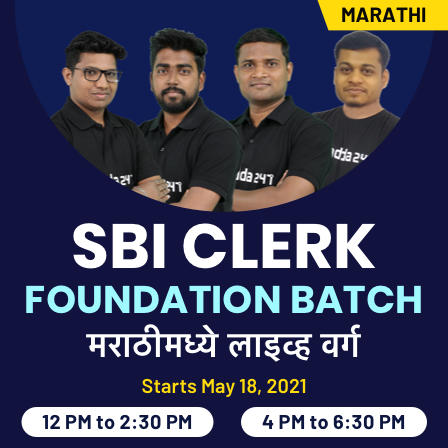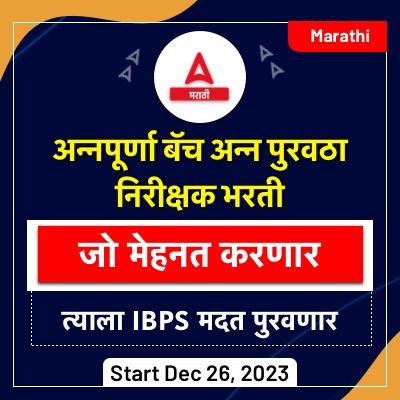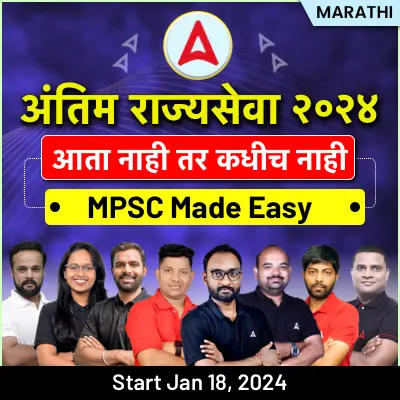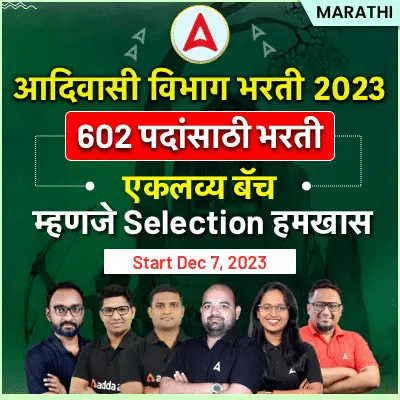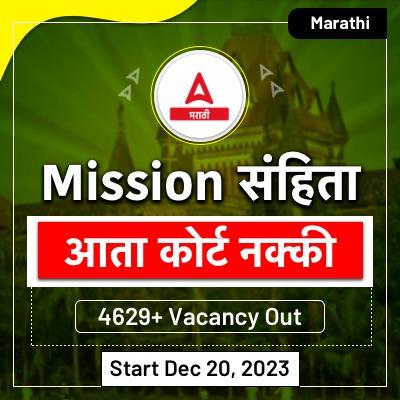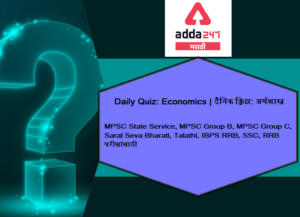
अर्थशास्त्र दैनिक क्विझ मराठीमध्ये: 19 मे 2021
महाराष्ट्र राज्य लोकसेवा आयोग दरवर्षी वेगवेगळ्या परीक्षे मार्फत हजारो विद्यार्थ्यांची भरती करून घेते MPSC State Service, MPSC Group B, MPSC Group C, Saral Seva Bharati, Talathi, UPSC, SSC, RRB अशा अनेक परीक्षांमार्फत हजारो जागांची भरती दरवर्षी निघते ज्यात लाखो इच्छुक हजार किंवा त्याहूनही कमी जागांसाठी अर्ज करतात. आपण एमपीएससी आणि इतर परीक्षाची तयारी करत असाल तर आपल्याला क्विझ देण्याचे महत्त्व माहित असलेच पाहिजे. बर्याच विद्यार्थ्यांना अभ्यासाचे पुरेसे तास दिले जात असतानाही त्यांना या परीक्षांची पूर्तताही करता आली नाही कारण ते त्यांचे परीक्षण वेळेवर पूर्ण करू शकत नाहीत आणि संशोधन करण्याचा उत्तम मार्ग म्हणजे त्या संबंधित विषयाची किंवा विषयाची क्विझ देणे कारण आपण या मार्गाने कव्हर करू शकता कमी वेळात जास्तीत जास्त विषय. आम्हाला Add 247 मराठी येथे चांगल्या अभ्यास सामग्रीचे मूल्य समजले आहे आणि म्हणूनच आम्ही सर्व विषयांसाठी आपल्याला क्विझ प्रदान करीत आहोत. दैनिक क्विझ देऊन तुम्ही तुमच्या तयारीची पातळी तपासू शकता.
चालू घडामोडी, भूगोल, अर्थशास्त्र, पर्यावरण, सामान्य विज्ञान, इतिहास, पॉलिटी अशा सर्व स्पर्धात्मक सामान्य अभ्यास विषयांमध्ये अर्थशास्त्राचाही महत्वाचा वाटा आहे. तर चला अर्थशास्त्र बद्दल तुमची तयारी तपासण्यासाठी खालील 19 मे 2021 ची अर्थशास्त्राची दैनिक क्विझ पहा.
Q1 “गोल्डन हँडशेक” हा शब्द पुढीलपैकी कोणत्याशी संबंधित आहे?
(a) दोन ब्लू-चिप कंपन्यांमधील सहयोग
(b) ज्यांनी नोकरी गमावली त्यांच्यासाठी एक उदारपणे विच्छेदन पॅकेज
(c) गुंतवणूकदार आणि कंपनीचे मालक यांच्यात नफा सामायिक करण्यासाठी सहकार्य
(d) दोन्ही देशांमधील आर्थिकदृष्ट्या अनुकूल व्यापार करार
Q2 पुढील विधानांचा विचार करा
1. वित्तीय तूट म्हणजे एकूण खर्च आणि कर्ज घेण्याशिवाय एकूण पावती यांच्यातील फरक.
2. भूतकाळाच्या कर्जामुळे निर्माण झालेल्या व्याजाच्या देयतेची जबाबदारी वगळून प्राथमिक तूट ही वित्तीय तूट आहे.
वर दिलेली कोणती विधाने बरोबर आहे / आहेत?
(a) फक्त 1
(b) फक्त 2
(c) दोन्ही 1 आणि 2
(d) 1 किंवा 2 देखील नाही
Q3 कमाईच्या तुटीबद्दल खालील विधानांचा विचार करा:
1. अर्थसंकल्पातील तूट रोखण्यासाठी आरबीआय सरकारकडून पैशाची छपाई करते
2. एफआरबीएम कायदा 2003 अंतर्गत थेट कमाई करण्याचा आरबीआयला अनिवार्य आहे
वर दिलेली कोणती विधाने बरोबर आहे / आहेत?
(a) फक्त 1
(b) फक्त 2
(c) दोन्ही 1 आणि 2
(d) 1 किंवा 2 देखील नाही
Q4. रिझर्व्ह बँक ऑफ इंडिया वापरत असलेल्या पत नियंत्रणासाठी खालील पैकी कोणती परिमाणात्मक पद्धती आहे?
1. रोख राखीव प्रमाण
2. तरलता समायोजन सुविधा
3. मार्जिनल स्टँडिंग सुविधा
योग्य कोड निवडा:
(a) 1 आणि 2
(b) 2 आणि 3
(c) 1 आणि 3
(d) 1, 2 आणि 3
Q5 पुढील पैकी कोणत्या मुद्रा बाजार साधनांचा परिपक्वता कालावधी एका वर्षापेक्षा जास्त असतो?
(a) कॉल पैसे
(b) कमर्शियल पेपर्स
(c) ट्रेझरी बिले
(d) ठेवीचे प्रमाणपत्र
Q6 चिट फंड ही एक योजना आहे जिथे पूर्व-निर्दिष्ट सदस्यांद्वारे दिले जाणारे मासिक योगदान त्यांच्यास फायद्याच्या पद्धतीने परत वितरीत केलेल्या मुदतीच्या एकूण चिट फंडाच्या रकमेमध्ये भर घालते. चिट फंड्स____यांचेद्वारे
नियमन केले जाते-
(a) एसईबीआय
(b) आरबीआय
(c) राज्य सरकारे
(d) व्यावसायिक व्यवहार मंत्रालय
Q7.निधी कंपनी ही एक एनबीएफसी आहे जी आपल्या सदस्यांमधील कर्ज देण्याचे आणि कर्ज घेण्याची कार्ये करते.
निधी कंपन्यांचे प्रशासकीय नियमन याद्वारे केले जाते-
(a) एसईबीआय
(b) आरबीआय
(c) राज्य सरकारे
(d) कॉर्पोरेट व्यवहार मंत्रालय
Q8 खालील पैकी कोणते अर्थव्यवस्थेतील महागाई नियंत्रित करण्यासाठी उपाय नाही?
(a) अप्रत्यक्ष कर कमी
(b) थेट कर कमी
(c) अनावश्यक खर्चामध्ये घट
(d) चलनाच्या उच्च संप्रदायाचे कमी करणे
Q9. जेव्हा वस्तू आणि सेवांच्या किंमती तसेच बेरोजगारीचे दर उच्च पातळीवर असतात तेव्हा अर्थव्यवस्था
खालीलपैकी कोणती परिस्थिती अनुभवत असते?
(a) निर्जंतुकीकरण
(b) स्तब्धता
(c) बूम
(d) विकृतीकरण
Q10 धोरणात्मक पेट्रोलियम साठ्यांबाबत खालील विधानांचा विचार करा
1. नैसर्गिक आपत्ती, युद्ध किंवा इतर आपत्तींपासून होणारा पुरवठा खंडित होण्याचा धोका यासारख्या कच्च्या
तेलाशी संबंधित कोणत्याही संकटाला सामोरे जाण्यासाठी कच्च्या तेलाचा मोठा साठा म्हणजे पेट्रोलियम साठा.
2. धोरणात्मक पेट्रोलियम साठा तयार करण्याच्या आंतरराष्ट्रीय अनिवार्य कराराखाली भारत आहे
3. भारताची रणनीतिकारक कच्च्या तेलाची साठे सध्या भारतातील 3 ठिकाणी आहेत
वर दिलेली कोणती विधाने बरोबर आहेत?
(a) 1 आणि 2
(b) 2 आणि 3
(c) 1 आणि 3
(d) 1, 2 आणि 3
Solutions
S1.Ans.(b)
Sol.
A golden handshake is a stipulation in an employment agreement that states that the employer
will provide a significant severance package if the employee loses their job. It is usually provided
to top executives in the event that they lose employment because of retirement, layoffs, or
negligence. However, payment can be made in several ways, such as cash or stock options. So,
option (b) is correct.
S2.Ans.(c)
Sol.
Fiscal deficit is the difference of total expenditure and receipts except for the borrowings and
other liabilities during the fiscal year. So, statement 1 is correct.
Primary deficit is the measure of the current year's fiscal operation excluding past borrowing'
interest payment head as it forms the major division under revenue expenditures. So,
statement 2 is correct.
S3.Ans.(a)
Sol.
What is direct monetization or money financing?
In layman’s language, monetization of deficit means printing more money.
In direct monetization, the government asks RBI to print new currency in return for new
bonds that the government gives to the RBI.
In lieu of printing new cash, which is a liability for the RBI (since every currency note has the
RBI Governor promising to pay the bearer the designated sum of rupees), RBI gets
government bonds, which are an asset for the RBI
Government bonds are an asset to RBI because they carry the government’s promise to pay
back the designated sum at a specified date.
Now, the government would have the cash to spend and alleviate the stress in the
economy
Note that this is different from the “indirect monetization” that RBI does when it conducts
the Open Market Operations (OMOs) and purchases bonds in the secondary market.
S4.Ans.(d)
Sol.
The Cash Reserve ratio is the emphasis of the central bank to maintain a certain proportion of
bank’s deposits in the form of liquid cash with the RBI, enforcing credit-control of banks by the
RBI. This control emphasizes the bank lend with caution across all sectors without
discrimination making it a quantitative credit control mechanism. So, statement 1 is correct.
Liquidity adjustment facility comprises of repo rate and reverses repo rate which can be used to
reduce the loan taking or giving the ability of banks from/to RBI, thereby controlling credit
availability regardless of sector allocation making it a quantitative credit control method. So,
statement 2 is correct.
Marginal standing facility MSF: It is the overnight loan facility given by RBI TO banks which have
an account with it, which affects the lending rate gradually. Repo rate is 1% more than reverse
repo rate and 1 % lesser than MSF. it a quantitative credit control method. So, statement 3 is
correct.
S5.Ans.(d)
Sol.
Treasury bills: These are non-interest-bearing coupons issued at a discount rate issued by
RBI on behalf of the central government. These bills are redeemed at par (original value)
within a return of less than one year. State governments are not allowed to issue T- bill.
Call money: Banks (with lenders and borrowers) and Financial institutions (only lenders and
not borrowers) transact in the call money market for loans to cover its cash requirement
ratio CRR with RBI. It is classified based on transaction duration into the overnight market
(less than one day) and short notice market (up to 14 days).
Certificate of deposit: Short-term debt securities issued by banks and financial institutions
with a maturity of 3months-1year and 1-3 years respectively. It is issued to open markets in
multiples of 25 lakhs with a minimum of Rs 1 crore. They are the same as fixed deposits with
higher interests and issued at par.
Commercial papers: Commercial papers are similar to a certificate of deposits but issued by
private companies in India. The commercial paper should be rated by credit rating agencies
to give an indication to investors. It is issued in denomination of Rs 5 lakhs multiples up to a
minimum of 1 crore with a maturity period of 3-6 months.
S6.Ans.(c)
Sol.
Chit fund is a scheme where monthly contributions from pre-specified members add to the total
chit fund amount for the term distributed back to them in a profitable manner, which is
regulated by respective state governments.
S7.Ans.(d)
Sol.
Nidhi company is an NBFC that performs lending and borrowing functions exclusively between
its members, which is administratively regulated by the Ministry of corporate affairs.
S8.Ans.(c)
Sol.
Measures to control inflation:
1. A decrease In indirect taxes will reduce the prices of the goods naturally making inflation
lower.
2. A decrease in indirect will enable more disposable income in the hands of people,
making the demand for goods increase thereby increasing the prices of goods increasing
the inflation.
3. Reduction in unnecessary expenditure by the government will reduce the money supply
in the economy by providing fewer jobs and will also reduce the government side of
demand, thereby reducing demand-pull inflation.
4. Demonetization: Announcing certain currency notes as invalid reduces the money
circulation in the economy suddenly. Though it is not a sustainable solution.
5. Issue of new currency: New currency of a single unit will be made equal to many units of
old currency as the same occurrence happened in Venezuela and Zimbabwe.
S9.Ans.(b)
Sol.
The rate of inflation at a slower rate is called disinflation. So, Option (a) is not correct.
Stagflation means low National Income Growth and High unemployment. The Philips curve
shows that at a high rate of inflation, there is low unemployment. So, Option (b) is correct.
It means rapid and significant sales growth, while a boom for a country is marked by significant
GDP growth. So, Option (c) is not correct.
It is opposite to that of inflation. The persistent and appreciable fall in the general levels of
prices is called Deflation. So, Option (d) is not correct.
S10.Ans.(c)
Sol.
Strategic petroleum reserves are huge stockpiles of crude oil to deal with any crude oil-related
crisis like the risk of supply disruption from natural disasters, war, or other calamities.
According to the agreement on an International Energy Programme (I.E.P.), each International
Energy Agency (IEA) country has an obligation to hold emergency oil stocks equivalent to at
least 90 days of net oil imports.
In case of a severe oil supply disruption, IEA members may decide to release these stocks to
the market as part of collective action.
India became an associate member of the International Energy Agency in 2017.
India’s strategic crude oil storage is currently located at Visakhapatnam (Andhra Pradesh),
Mangaluru (Karnataka), and Padur (Karnataka).
The government has also given approval for setting up two additional facilities at Chandikhol
(Odisha) and Padur (Karnataka).


